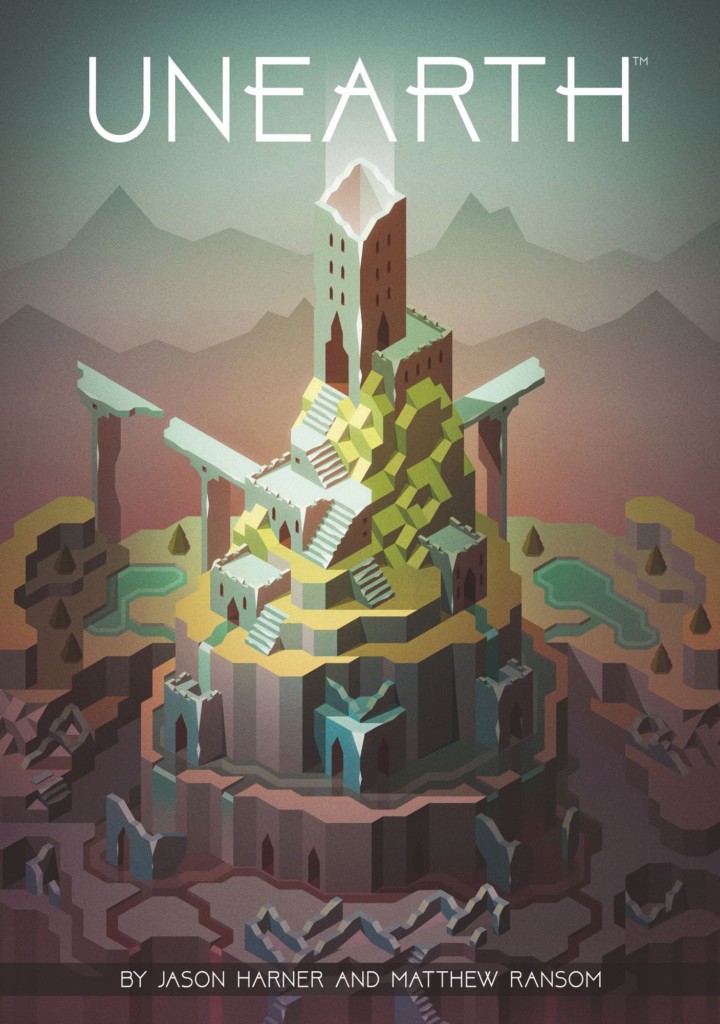In Unearth you’ll roll cubes to get either cube tiles or cards showing ruined towers of cubes…
Cubes.
Long ago, your ancestors built great cities across the world. Now your tribe must explore forests, deserts, islands, mountains, and caverns to find these lost cities. Claim the ruins, build places of power, and restore the glory of a bygone age.
Unearth Game Play
Each player gets 2 very small Delver cards and an overly large card from the Ruin deck which you can look at, but keep face down. Players also have 3x D6, 1x D8, and 1x D4 to use on their turn.
5 Ruins are placed face-up on the table. On the bottom of a ruin card is a number showing the number of stone hex tiles that are pulled from a bag and placed next to that ruin.

That’s the main area, off to the side are the Wonders which we’ll talk about later.
At the start of a player’s turn, they can play any number of delver cards from their hand. These have different abilities that will activate on the player’s excavation phase this turn.

Then is the excavation phase itself where a player chooses a die and a ruin in the middle of the table. They roll the die and add it to the ruin and if the value is 1, 2, or 3 they get to take a stone from that ruin.
Then you check the value of the ruin in the top left vs the total of all dice on that ruin, that’s dice from all players. If it’s equal to or higher, the player that placed the highest total of dice gets to take that ruin, it’s then replaced from the deck.
Players get their dice back and those that didn’t win the ruin card take one delver card per dice retrieved as a reward.
Stones & Wonders
When you take stones you put them in circles of Hexes. To take a named wonder, you need to make a circle of 6 stones of a specific colour as listed on its card. There are generic wonders in every game, the greater wonders that need 6 of the same colour and lesser wonders that use any 6 stones but they’re not as good. Named wonders will give end-game points and/or abilities.

Once all ruin cards have been claimed the game ends. Players score 2-30 points for sets of 1-5 of the same type of ruin plus 5 points for each full-colour set.
Add points from wonders and 5 points if you built 3 wonders, most points will be the winner!
Theme
Bit weird innit?
I like the look of the world and it doesn’t make much sense, but I don’t care!
Setup
This is fine. You have to choose from a few different named wonders but everything else is straightforward.
Components & Artwork
The components are fine. The cards, dice and stone tokens are all standard.
The art is weird but pretty good. it has a nice unique look that I would like to see in more games.

Ease of Teaching & Accessibility
Very simple. The options available to a player on a turn are easy to explain. The only hidden information is the delver cards and they can be explained, not that it will be needed.
The rest, including scoring and Wonders, is up to just teaching the game well.
Unearth Summary
I don’t think I’ve played many area control games that use dice that aren’t a smaller mechanism in a larger euro game. Artifacts, Inc. was one but I can barely remember it. I feel it was pretty good but played slowly.
Dicetopia is another but it’s in reverse where you remove dice to control an area.
The dice placement and fight over the cards are more interesting than the set collection which is a problem as that’s a large portion of the scoring. Your D8 will hopefully give you a big number pushing you towards getting that card. But, your D4 and its very good chance of getting a 1-3 can help get that stone you need.

I did find the stone collection and arrangement interesting and unique. Trying to get the stone to build the named temples before the other players were good fun.
Apart from that, it is quite average. I mean, I wouldn’t ‘not’ play Unearth again, but I don’t think I would request it.
Jesta ThaRogue



Leave a Reply